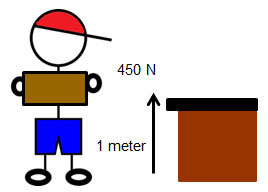

Imagine you were trying to move boxes from one side of the room to another. You could push the boxes across the room, but that would require a lot of force. If you used a dolly, it would require less force on your part. A dolly is an example of a machine. Machines make work easier by changing the size, distance, or direction of a force you have to exert. Machines do not decrease the total amount of work.
You might think of a machine as a complex mechanical device, but machines are not always either complex or mechanical. Simple machines have only one moving part. There are six types of simple machines including the lever, the inclined plane, the wedge, the screw, the pulley, and the wheel and axle. All machines are made from one or more of these simple machines.
![]() Click on the images below to review the different types of simple machines.
Click on the images below to review the different types of simple machines.
When you do work with a machine, you exert a force over a distance. The force you exert on the machine is called the input force. The machine does work by exerting a force over a distance. The force exerted by the machine is called the output force. In the image below, a screwdriver is used as a lever to open a paint can. When you use a machine, such as this lever, you apply work to the machine, and the machine does the work on something else. In this example, the input force is applied to the screwdriver as you move it down. The lever exerts the output force and opens the lid. The width of the arrows representing the input force and output force indicates the relative size (amount) of the forces. The length of the arrows indicates the distance of the forces.

Source: Paint Can, painetworks
The images below show several simple machines and the input and output forces. Pay close attention to the size and length of the forces.
 |
 |
 |
|
It is important to remember that machines do not save or lessen the amount of work; they only change the size, distance or direction of a force you have to exert. Let's look at an example problem to prove this.

Jason needed to move a box from the ground to a shelf that was 1 meter off the ground. Doing this required a force of 450 Newtons.
How much work was done?
Interactive popup. Assistance may be required. W = Fd

Now, let's say that Jason decided to use an inclined plane or ramp to help him move the box. This will require less input force on Jason's part, only 150 newtons, but now the box must be moved 3 meters up the inclined plane.
Interactive popup. Assistance may be required. W = Fd
As you can see, the amount of work is the same, 450 J, but the force Jason had to exert is much less using the simple machine.
Work output can never be greater than work input. This means when a machine is used to do work, either the force or the distance through which the force is applied may increase, but not both at the same time. In other words, when force or distance increases, the other must decrease. This is called the force-distance trade off.
The diagram below is a model of work being completed using a machine. The work input is shown on the left side, and three possible scenarios for work output are on the right side. The distance the object would move is given. Drag the output force to the correct location to show the force-distance trade off.
![]()